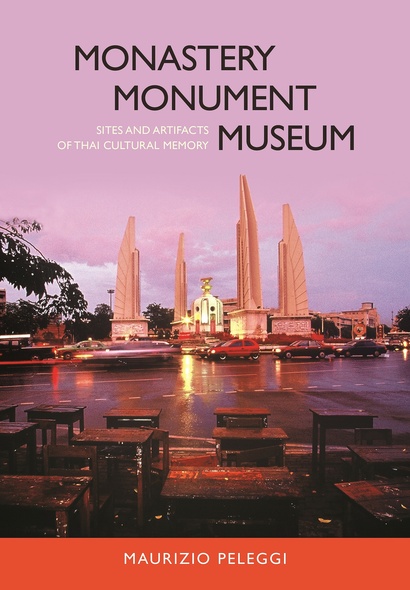
Monastery, Monument, Museum
Sites and Artifacts of Thai Cultural Memory
Ranging across the longue durée of Thailand’s history, Monastery, Monument, Museum is an eminently readable and original contribution to the study of the kingdom’s art and culture. Eschewing issues of dating, style, and iconography, historian Maurizio Peleggi addresses distinct types of artifacts and artworks as both the products and vehicles of cultural memory. From the temples of Chiangmai to the Emerald Buddha, from the National Museum of Bangkok to the prehistoric culture of Northeast Thailand, and from the civic monuments of the 1930s to the political artworks of the late twentieth century, even well-known artworks and monuments reveal new meanings when approached from this perspective.
Part I, “Sacred Geographies,” focuses on the premodern era, when religious credence informed the cultural alteration of landscape, and devotional sites and artifacts, including visual representation of the Buddhist cosmology, were created. Part II, “Antiquities, Museums, and National History,” covers the 1830s through the 1970s, when antiquarianism, and eventually archaeology, emerged and developed in the kingdom, partly the result of a shift in the elites’ worldview and partly a response to colonial and neocolonial projects of knowledge. Part III, “Discordant Mnemoscapes,” deals with civic monuments and artworks that anchor memory of twentieth-century political events and provide stages for both their commemoration and counter-commemoration by evoking the country’s embattled political present.
Monastery, Monument, Museum shows us how cultural memory represents a kind of palimpsest, the result of multiple inscriptions, reworkings, and manipulations over time. The book will be a rewarding read for historians, art historians, anthropologists, and Buddhism scholars working on Thailand and Southeast Asia generally, as well as for academic and general readers with an interest in memory and material culture.
Peleggi writes with great narrative skill and his work is based on a variety of sources including royal/national chronicles, modern literature, visual materials and ethnographic data. Thirty-eight well-chosen illustrations complement this fascinating account. With extensive notes that contain encyclopaedic reviews and useful bibliography, this splendid volume is an incredibly rich resource for cultural scholars working on Thai and Southeast Asian studies, and for academics who seek methodological insights in conducting memory and material culture studies.
Maurizio Peleggi’s new book joins a very few texts on Thai art and cultural history that have both a developed historical view and a willingness to synthesize across existing institutional and disciplinary frames. As an old Roman, aware of much European discourse on medieval history and fully conversant with many broader approaches by art history to images and monuments, Peleggi brings a quiet, incisive and worldly-wise grandeur to his perceptions.
Thailand’s mnemonic landscape is famous with tourists as well as scholars. Peleggi recounts for us the various moments, modes, and contexts in which it was created, from the Buddhist art and iconography of early times, to the modern scholarship of archaeology and art history under colonialism and the Cold War, to the politics of monuments and the arts of the unspeakable more recently. This enjoyable story is full of the intrigues and ironies that a conventional history would pass by.
Maurizio Peleggi is professor of cultural history at the National University of Singapore.





